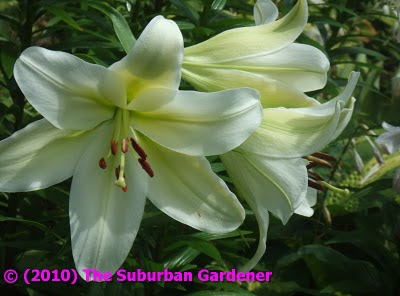Hello there everyone. I apologize for my long absence. Been busy all these days and today, I've finally found the time to do a post. No amaryllis is blooming yet. Lima is on the verge and everything else are still asleep.
Sharing with you what is going on here and what are my future endeavors.
 The Muscari armeniacum bulbs I planted on Christmas eve are now growing. After a week in the cold and dark spot in the basement, they were so eager to grow as seen on the above photo. Muscaris send up leaves in the fall and they stay green all winter, then their flowers come up in spring. (Just mentioning this fact for my readers in tropical climate.) I have patches of album and armeniacum growing in the garden and are planted where the snow thaws first when the temperature warms up. It is great to see those green leaves in winter time, sign of the arrival of spring.
The Muscari armeniacum bulbs I planted on Christmas eve are now growing. After a week in the cold and dark spot in the basement, they were so eager to grow as seen on the above photo. Muscaris send up leaves in the fall and they stay green all winter, then their flowers come up in spring. (Just mentioning this fact for my readers in tropical climate.) I have patches of album and armeniacum growing in the garden and are planted where the snow thaws first when the temperature warms up. It is great to see those green leaves in winter time, sign of the arrival of spring.
 This is how they look right now. I put them under regular fluorescent lights. The Poeticus Recurvus daffs are planted in the bottom of the pot. I hope the daffs will bloom in the spring. I am concerned that they are not getting enough cold treatment.
This is how they look right now. I put them under regular fluorescent lights. The Poeticus Recurvus daffs are planted in the bottom of the pot. I hope the daffs will bloom in the spring. I am concerned that they are not getting enough cold treatment.

I started sowing some of my lily seeds (following the Cramer method). These are the results of my maiden hybridization efforts last year. I started with asiatics and trumpets, both divisions are easy to grow as they germinate epigeally. The crosses in the containers are Centerfold x Chianti, Tiny Ghost x Lollipop and Tiny Todd x Tiny Ghost. The trumpet crosses will be sown soon. (The tags you see are from B and B's and I reused them.)
 These seedheads are from a gardening friend and winter sown them today as seen on the bottom photo. I have been reading about winter sowing and tried it.
These seedheads are from a gardening friend and winter sown them today as seen on the bottom photo. I have been reading about winter sowing and tried it.


Pulsatilla seeds sown today.
These are from a trading friend in Minnesota. I read that they are kind of tricky to grow, requiring warm period of germination followed by cold treatment. If anybody grew this plant from seeds, please share your experience.
 Trillium grandiflorum from eBay.
Trillium grandiflorum from eBay.I found them in bad state. The growth on the rhizomes are drying out except for one. Stored in the fridge for a few months in peat moss, potted them up today and I put them in a cold area and see if they will come up in spring.
 Lily seeds from NALS and Dr. Griesbach.
Lily seeds from NALS and Dr. Griesbach.
 Lily seeds from my crosses.
Lily seeds from my crosses. It will take me a while to finish sowing all of these seeds.
 Liatris spicata seeds.
Liatris spicata seeds.
 Hosta Ventricosa seeds.
Hosta Ventricosa seeds.
I have collected some seeds for my winter sowing project. This hosta variety is an oldie but goodie with dark green leaves and dark purple flowers and the only hosta I know that comes true from seed.
So much stuff to do, so little time. :)




 Photo: Doug Westfall (www.bulbsociety.org)
Photo: Doug Westfall (www.bulbsociety.org) Photo: Doug Westfall (www.bulbsociety.org)
Photo: Doug Westfall (www.bulbsociety.org)















